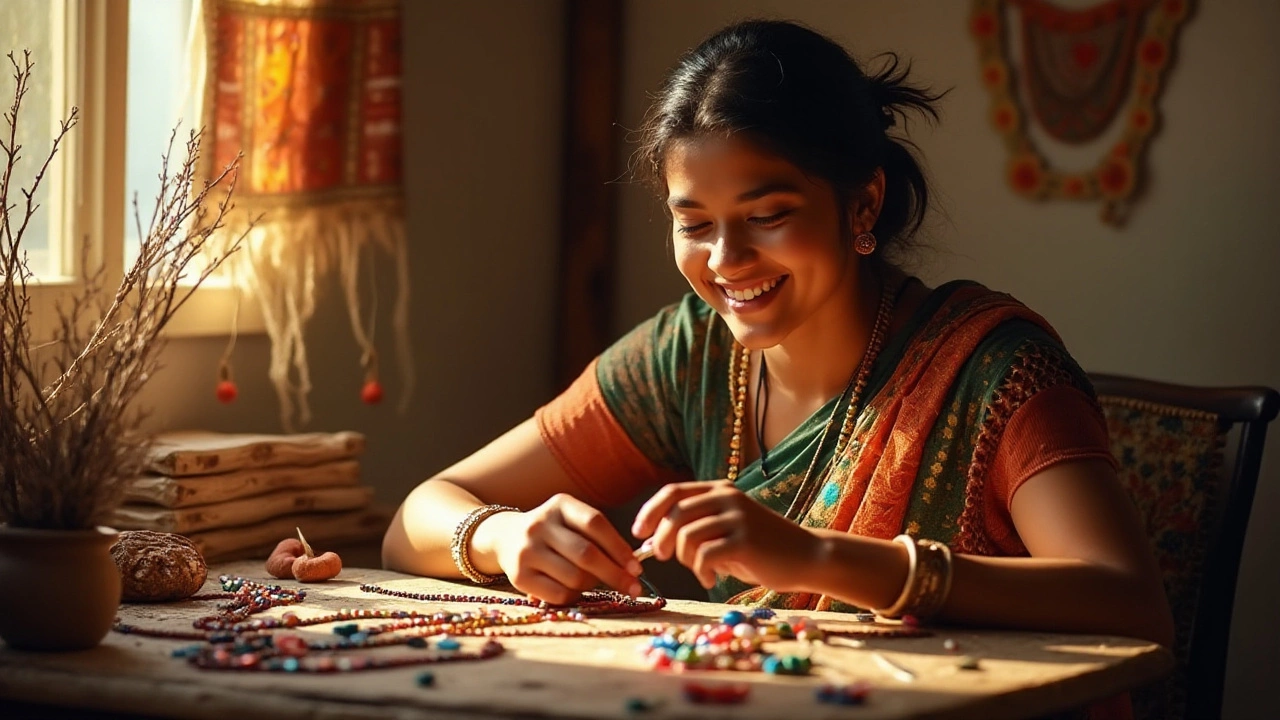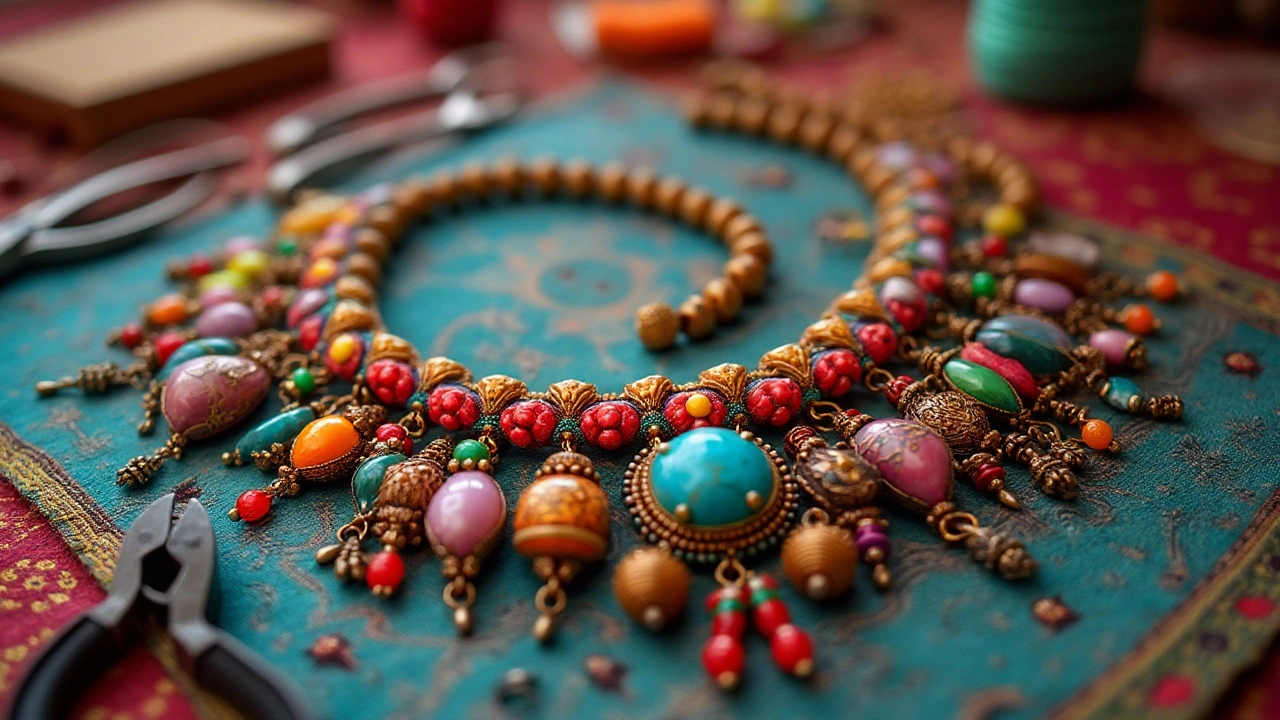
Jewelry making is not just an art form; it's a doorway into creativity and personal expression. Starting with the easiest types of jewelry to make allows enthusiasts to dip their toes into this creative realm without feeling lost. Beaded jewelry often emerges as the go-to choice for beginners due to its simplicity and versatility.
Delving into jewelry creation for the first time doesn't have to be daunting. With the right kit, even a novice can craft pieces that are both stunning and satisfying to create. These kits often include all necessary components, removing the hassle of sourcing materials individually. It's about learning something new while enjoying the process.
In exploring the simplest jewelry creations, one uncovers not only the joy of making but also the surprising history embedded in these tiny treasures. It's a path lined with discovery, creativity, and sometimes even unexpected insights. So grab your kit and let's start a charming journey into the world of jewelry crafting.
- Why Start with Jewelry Making Kits
- Essential Tools and Materials
- Understanding Beaded Jewelry
- Exploring Wire and Thread Techniques
- Tips for Choosing Your First Kit
Why Start with Jewelry Making Kits
Embarking on the journey of crafting your own jewelry is like stepping into a universe of endless sparkle and creativity. Jewelry making kits serve as a delightful entry point to this creative endeavor, removing the obstacles that often accompany starting something new. These kits are specifically designed to be beginner-friendly, providing you with all the materials and instructions needed to create beautiful pieces right out of the box. For those who are unsure where to begin, a jewelry making kit is like having a friendly guide leading you through the basics.
Imagine receiving a kit that contains everything from beads, chains, and clasps to detailed instructions that walk you through each step. It’s a bit like painting by numbers, but instead of a picture, you’re crafting something you can wear and display. This approach not only saves time but also reduces the intimidation factor that can come with shopping for materials. Besides, many people find that having everything in one place helps them focus on the joy of crafting rather than the logistics. According to craft expert and author, Joy Elfman,
"Jewelry kits are brilliant for getting started because the hardest part—sourcing everything—is already done for you."
Another benefit of starting with beginner jewelry crafts is the curated nature of the components. Typically, the pieces within a kit are chosen to complement each other, which is ideal for someone who hasn’t yet developed a keen eye for design. This curated combination allows new crafters to focus on mastering the techniques without worrying if their color choices clash or if the materials fit with each other stylistically. Also, the kits often come with varying difficulty levels, ensuring that you can find one that matches your skill set and gradually move up to more complex projects as your confidence and competence grow.
Many jewelry making kits are comprehensive and also include tools that may be a bit of an investment separately. For someone just starting, being able to experiment with proper tools without breaking the bank is a significant advantage. A kit might include pliers, cutting tools, and measuring devices necessary for your first foray into DIY jewelry creation. It’s much like having a mini workshop at your disposal, ones that don't require large amounts of storage space. This practicality ensures you’re ready to work whenever the creative muse strikes.
Using a kit can certainly ramp up your crafting confidence. The sense of accomplishment derived from successfully completing your first piece of jewelry is invigorating. It might begin with a simple beaded bracelet or earrings, yet with every piece, your skills and imagination grow. Often, participants of bead workshops express delight in how the guided simplicity of kits propels their interest into a passionate hobby.
Essential Tools and Materials
Diving into the world of jewelry crafting begins with understanding the essential tools and materials you'll need to bring your creations to life. Whether you're assembling your first beaded bracelet or experimenting with wire, these tools are the cornerstone of your craft kit. It's not unusual to feel overwhelmed by the myriad of options, but starting simple can be the key to a fruitful journey.
The most fundamental tool you will encounter is the set of pliers. Specifically, round-nose and chain-nose pliers are indispensable for manipulating wire, closing jump rings, and creating loops. These tools offer precision and control, essential for intricate details that set your design apart. Investing in ergonomic handles can make a world of difference, particularly when you're working on projects that demand time and attention.
When it comes to materials, beads are often the primary component in beginner jewelry kits. They come in countless shapes, sizes, and materials including glass, wood, and plastic. Wooden beads, for example, offer a rustic charm, while glass beads add a splash of color and elegance. Pairing these with elastic thread or beading wire creates a sturdy yet flexible backbone for your designs. Elastic thread is forgiving and easy to work with, making it ideal for stretchy bracelets, while beading wire provides durability necessary for necklaces and more structured pieces.
Don't underestimate the significance of a good bead mat. While it might seem a minor accessory, it prevents beads from rolling away and gives you a clear space to lay out your designs. Measuring tools, like a simple tape measure or a specialized bead ruler, ensure your pieces fit perfectly and add to the professionalism of your crafts.
"The right tools make all the difference between frustration and success when it comes to crafting," as stated by renowned jewelry artist Erika Knudsen.
Clasps and findings, the mindful accessories that finish a piece, are another category of materials in your kit. Toggle clasps, lobster clasps, and jump rings are key to linking sections together, offering secure closure and sometimes even a touch of flair to your designs. If sustainability is high on your priority list, consider sourcing materials from reputable suppliers who prioritize eco-friendly practices, reflecting this thoughtful choice in your creations.
A part often overlooked by budding jewelers is the adhesive. Strong craft adhesives or jeweler's glue can be your secret weapon in securing stones, beads, and embellishments firmly in place. They also offer peace of mind that your carefully crafted piece will endure through wear and time.
Embarking on your creative journey with a comprehensive understanding of your tools will not only bolster your confidence but also enhance the pleasure and success of every project you undertake. The right combination of tools and materials forms the bedrock of your creative potential, enabling you to transform simple beads and wire into cherished masterpieces. With these essentials in your toolkit, the possibilities for creating beautiful jewelry are bound only by your imagination.

Understanding Beaded Jewelry
Beaded jewelry, with its rich history and diverse global roots, offers an inviting gateway into the world of crafting accessories. It has adorned humans since ancient times, showcasing an array of cultural expressions and personal styles. From simple strands of jute threaded with shells to intricate patterns that involve hundreds of tiny seed beads, this craft is as varied as the artisans who practice it. When diving into beaded jewelry, one can explore an astonishing spectrum of colors, sizes, and textures, allowing endless experimentation. The materials for beading range from glass and crystal to wood and clay, each adding a distinct character to the finished piece. Beads are not just decorative—they often carry stories, serving as personal talismans or symbols of identity. This makes beading not only an accessible hobby for beginners but a deeply personal expression of art.
For those starting their journey in creating DIY jewelry, understanding the types of beads and their applications is crucial. Seed beads, typically small and round, come in various sizes and finishes, making them ideal for detailed designs and patterns. On the other hand, gemstone beads bring an element of elegance and depth with their natural hues and unique variations. To better understand the appeal of beaded jewelry, consider this: the ancient Egyptians used lapis lazuli and turquoise in their beadwork, believing them to possess protective properties. This belief blends beauty with mythology, transforming simple adornments into significant cultural artifacts. Crafting bead necklaces can be as simple or complex as you choose, allowing creators to grow their skills progressively. As you begin exploring this craft, you'll find that each bead holds a myriad of possibilities in its tiny frame.
The process of creating beaded jewelry is meditative, often likened to stringing together moments of creativity and calm. Selecting beads, arranging them into a pattern, and securing them on a string transforms raw materials into something meaningful and personal. Many beginners appreciate the intuitive nature of beading; you don't necessarily need to follow rigid rules to achieve beautiful results. Starting with a basic jewelry making kit can significantly enhance the learning curve. These kits usually provide all necessary tools, such as beading needles, strings, and, of course, beads of assorted kinds. As you progress, you might even venture into creating your patterns, which can elevate your projects from straightforward designs to much more elaborate pieces.
"Beads are stories. They're like memories worn with the intent," says Fay Schopen, highlighting the narrative nature embedded within each crafted piece.
The beading landscape is vast and offers something for everyone, whether you seek a hobby to relax or a way to express your creativity in a tangible form. As you gain confidence, experimenting with different beading stitches such as peyote or brick stitch can add complexity to your designs, leading to gratifying outcomes. When placed side by side, even a simple arrangement of beads can create a piece that is captivating and uniquely yours. Aspiring jewelry makers stand to gain immense satisfaction from the tactile experience of crafting beaded jewelry, where no two pieces are exactly alike. The intricate dance of dexterity and imagination means that, with each finished piece, you contribute to an art form that transcends the boundaries of time and culture. It might be useful to note, given current trends, beaded bracelets and necklaces are making a significant comeback both in casual and formal fashion settings, showing how contemporary styles continue to revitalise traditional crafts.
Exploring Wire and Thread Techniques
Jewelry-making is an adventure that offers both creativity and a connection to ancient craftsmanship. When diving into wire and thread techniques, even the simplest tools can unlock a world of possibilities. For instance, with wire, an aspiring jeweler can create intricate designs ranging from graceful loops to daring geometric forms, while thread offers a tactile delight that interweaves patterns and colors into harmonious strands.
Wire work, in particular, demands precision and patience but offers expressive possibilities. It includes hammering, wrapping, and shaping, inviting makers to explore the nuances of texture and form. Did you know that copper wire remains the favorite due to its flexibility and expense? Its use dates back to ancient Egypt, where artisans crafted stunning adornments. Today, a pair of pliers, a wire cutter, and your choice of wire can set you on the path to making trinkets that feel modern yet speak of history.
Thread techniques, on the other hand, offer a subtler touch, often used in making friendship bracelets or knotted necklaces. The satisfaction of these methods lies in the rhythmic repetition, evident in techniques like macramé or kumihimo, both revered for their hypnotic charm. These threading skills are versatile, letting crafters play with materials ranging from humble hemp twine to luxurious silk cords. It's quite intriguing to see how different threads give the design an entirely unique character, influencing the drape and impact of the final piece.
Choosing the Right Materials
The decision-making process behind selecting materials for wire and thread techniques is as essential as mastering the technique itself. When choosing wire, a beginner might start with 20-gauge wire to ensure it's both malleable and robust enough for practice. Meanwhile, size plays a crucial role with threads; for example, thicker cords provide sturdy support for larger beads, while thinner threads weave delicate patterns. Jewelry kits often include a selection of starter materials, simplifying initial forays into the art without diminishing the creative challenge.
A commitment to practicing these techniques can lead to an impressive array of personal adornments. As you intertwine strands and shape metals, each creation becomes a testament to skill and vision. Embrace the imperfections and quirks as signatures of individuality. They are what make each piece truly yours, unique in a world of mass production. Ultimately, exploring jewelry making kits with wire and thread opens pathways to artistry that are rich in both personal fulfillment and historical reverence. The journey begins with a single twist or knot, leading to a tapestry of storytelling through adornment.

Tips for Choosing Your First Kit
Diving into the world of jewelry making kits can be akin to stepping into a candy store; the choices are delightfully vast and varied. The key to making your first venture a success lies in selecting the right kit that aligns with your interests and skill level. It’s easy to get overwhelmed, so focusing on a few key aspects can streamline the decision-making process significantly. Start by considering what type of jewelry you are naturally drawn to. Are you enchanted by the simplicity of beaded necklaces, or do intricate wire designs capture your imagination? Answering these questions helps narrow your options, ensuring you choose a kit that aligns with your creative vision.
Beginner jewelry crafts often include beadwork, which not only teaches design and color coordination but also requires minimal tools. A good starter kit will typically contain beads, thread or wire, basic findings like clasps and jump rings, and a set of beginner-friendly tools. It's crucial to ensure that the kit includes clear instructions or tutorials, either in a printed format or through accessible online resources, which can guide you step-by-step through each project. This is particularly important if you are a visual learner or new to crafting.
"The best projects for beginners offer a balance between guidance and creative freedom, making the crafting process both educational and enjoyable," says Heather Drestle from The Craft Journal.
Price is another vital consideration. While it might be tempting to opt for the most economical solution, sometimes investing a little more can provide better quality materials and tools that last, offering a more enjoyable creative experience. Remember, the goal is to cultivate a love for making, so working with subpar materials can be disheartening. Additionally, if the kit requires any additional purchases, such as specialized tools or extra beads, this should be clearly stated up front to avoid unexpected costs.
When contemplating DIY jewelry, it's beneficial to read reviews from others who have tried the kit. Online platforms and forums can be valuable resources for discovering firsthand insights about the kit’s quality and the experience of using it. This peer feedback can be invaluable, guiding you toward a choice that is well-regarded and meets its advertised promises. Also, look for kits from reputable brands that specialize in crafting, as they are more likely to provide support and follow-up resources for new jewelers.
If possible, look for kits that offer room to grow. While it's wise to start with straightforward projects, consider kits that introduce new techniques or include access to a broader array of projects. This will ensure you’re not only learning but also progressing in your skills without needing to purchase new kits frequently. Choose a kit that sparks joy and motivates you to explore your creativity. When you connect with your materials and projects, you’re more likely to experience fulfillment and continue with this enriching craft.




